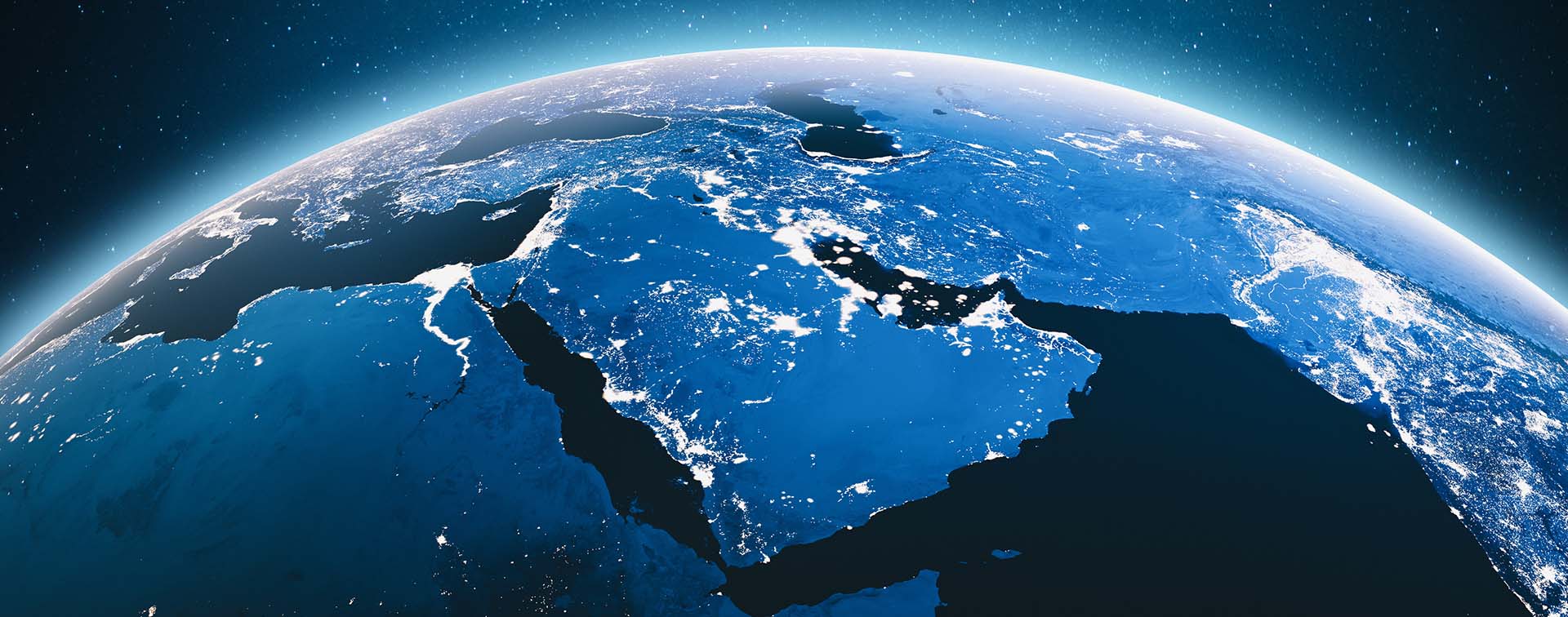
Dr. Robert Mogielnicki is a Senior Resident Scholar at the Arab Gulf States Institute in Washington and an Adjunct Assistant Professor at Georgetown University.
Middle Eastern and North African (MENA) countries confront a complex mix of domestic, regional, and international challenges. The incoming administration of President-elect Donald Trump is expected to bring major changes to US foreign policy towards MENA governments and in terms of American engagement on pressing regional issues. Wealthy and stable MENA countries are cautiously seeking opportunities with international partners outside the volatile region, primarily driven by domestic imperatives.
As the year commences, war and conflict continue to rage across the Middle East as they did throughout 2024, with Israel, Gaza, and Lebanon at the epicenter of the region’s instability. The Hamas attacks on 7 October 2023 and ensuing Israel–Hamas war is inflicting catastrophic damage on civilians and infrastructure. Tel Aviv initiated a new military front against Hezbollah in Lebanon and has attacked military targets in Iran. The conflict also spilled over into Syria and Yemen, where Israel has struck non-state actors such as the Houthis and other Iran-backed militant groups. The targeted killings of high-profile figures, such as Hamas leaders Ismail Haniyeh and Yahya Sinwar, and Hezbollah leader Sayyed Hassan Nasrallah and his presumed successor, have heightened concerns about the escalation of broader regional conflicts.

Yet an “all-out war” in the Middle East has not materialized. Instead, conflicts have largely remained contained to specific theaters. Gulf Cooperation Council (GCC) countries have urged de-escalation, and Gulf officials are concentrated on efforts to insulate their countries from the worst effects of regional wars. Israel and Hezbollah even agreed to a fragile ceasefire deal on 26 November 2024. The agreement, which the USA and France helped orchestrate, is partially related to growing conflict fatigue. Nevertheless, both Israel and Hezbollah have accused each other of violating the terms of the agreement and exchanged air strikes and other forms of attacks.
The most dramatic development of late 2024 involved the spectacular collapse of the regime of Bashar al-Assad in Syria, where a rebel offensive led by Hayat Tahrir al-Sham (HTS) toppled his dictatorship after a grueling 14 years of civil war. Syrians now confront the challenges of forming an inclusive and stable government, addressing mounting humanitarian needs, and initiating economic recovery efforts. Syria’s Arab neighbors are wary of HTS, an Islamist group that the U.S. State Department designated as a Foreign Terrorist Organization in 2018, and new forms of chaos unfolding in a post-Assad Syria. The fate of terrorism designations and sanctions on Syria will determine how global governments and international business actors engage with the country.
Governments across the region remain concerned about ongoing threats to their economies and security. Jordan faces significant security and political challenges for the foreseeable future. Iraq is increasingly in the crosshairs of rising tensions between Israel and Iran-backed militias operating on Iraqi territory. Egypt, although largely spared direct spillovers from the war in Gaza, has seen a significant drop in revenue from Suez Canal transit fees following Houthi attacks in the Red Sea, which has stressed the country’s troubled economy. Other North African countries remain relatively distanced from the regional conflict but nevertheless contend with challenging internal political dynamics.
The election of Donald Trump as 47th president of the USA was largely welcomed across Middle Eastern capitals. His commercial brand is a familiar one in MENA countries — and an especially visible feature of Gulf countries. President-elect Trump’s second, non-consecutive term in office promises significant changes in US Middle East policy from that of the Biden administration, especially concerning Iran, Israel, energy, and trade. The incoming president has vowed to secure peace in the Middle East, but it is unclear precisely how his Middle East team will manage an increasingly complex regional portfolio.
Trump is expected to revive a maximum-pressure strategy on Iran, aiming to isolate the Islamic Republic diplomatically and weaken its economy. Brian Hook, a former US Special Representative for Iran, indicated that he expects Gulf countries, some of which have eased tensions with Iran in recent years, to help deter Iranian aggression. Under the new Trump administration, the US government will likely increase its support for Israel and its domestic and regional actions, and push to expand the Abraham Accords — the diplomatic framework under which Bahrain, Morocco, Sudan, and the UAE normalized ties with Israel — to include Saudi Arabia.
The president-elect’s intent to establish “energy dominance” through supportive government policies presents a mixed bag of implications for energy producers in the Middle East. His administration will strongly defend fossil fuels and seek to capitalize on oil and gas production, aligning with both the rhetoric and the strategies of Middle Eastern energy-producing states. Yet rising US production levels of oil and gas would impact on global energy prices, which are directly linked to fiscal dynamics across much of the region, and complicate OPEC+ efforts to manage them. Saudi Arabia's National Debt Management Center estimates the country’s funding needs this year to be approximately USD 37 billion, which will cover the budget deficit and repay maturing debt.
The potential for steep tariffs on US trading partners may further weigh on global growth and energy demand. Bahrain, Israel, Jordan, and Oman enjoy free trade agreements with the USA, a preferential trade status that may attract greater trade flows amid a tariff-prone period in the global system. In November 2024, President-elect Trump threatened to impose 100% tariffs on BRICS countries — an intergovernmental organization that Egypt and the UAE formally joined in early 2024 — pursuing plans to create a new currency.
A more confrontational tenor to strategic competition between the USA and China, which new tariffs on China may trigger, could further complicate MENA governments’ delicate balancing of US partnerships against robust, multi-faceted relations with its major competitor. However, steep tariffs may be more threat than reality: President-elect Trump suggested a tariff on imports from China of up to 60% during his 2024 campaign but then after his election wrote on Truth Social “we will be charging China an additional 10% Tariff, above any additional Tariffs”.
Wealthy, stable states in MENA are taking steps to enhance global mobility and integration. In October 2024, for example, the UAE and U.S. Customs and Border Protection launched a partnership allowing Emirati citizens to apply for Global Entry membership. There are also efforts to enhance mobility eastward, such as the Saudi tourism minister’s suggestion that his country should explore options for greater visa-free travel with China.
Regional conflicts nevertheless entail mobility-related risks. International airlines have suspended flights and are avoiding air space affected by ongoing conflicts or anticipated retaliations, hampering regional connectivity. Iran, Iraq, Israel, and Lebanon have been particularly impacted. Other mobility barriers exist. Israel’s National Security Council stressed its travel warning to the UAE after the killing of a Chabad rabbi in the Gulf country, where a small Jewish community is reassessing vulnerabilities.
Despite headwinds facing the region, regional actors will continue in their efforts to enhance economic and other ties to key global markets throughout 2025. The GCC and European Union hope to build on the outcomes of their first summit held on 16 October 2024, while Gulf leaders are planning for the GCC-Central Asia Strategic Dialogue in Samarkand in Uzbekistan in 2025. The GCC and New Zealand concluded negotiations for a free trade agreement late last year, and the UAE continues to build a global network of partners through its Comprehensive Economic Partnership Agreements. Other nascent economic corridors — such as the India–Middle East–Europe Economic Corridor, and the Türkiye–Iraq Development Road project, which entails Emirati and Qatari support — will progress further, albeit unevenly, in what is expected to be a tense and disruptive year.
Henley & Partners assists international clients in obtaining residence and citizenship under the respective programs. Contact us to arrange an initial private consultation.

Have one of our qualified advisors contact you today.
We use cookies to give you the best possible experience. Click 'Accept all' to proceed as specified, or click 'Allow selection' to choose the types of cookies you will accept. For more information, please visit our Cookie Policy.